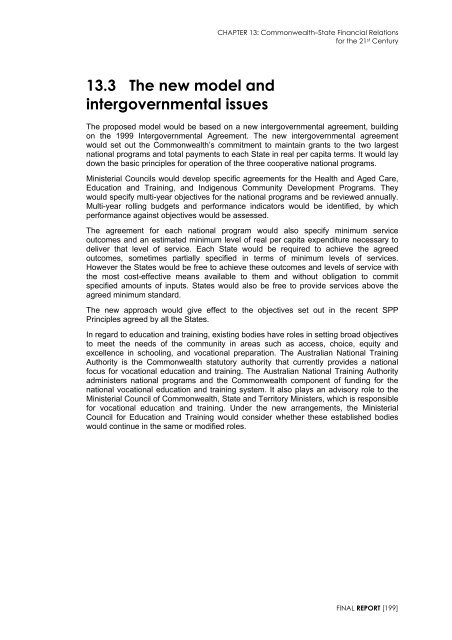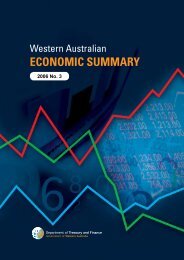Garnaut Fitzgerald Review of Commonwealth-State Funding
Garnaut Fitzgerald Review of Commonwealth-State Funding
Garnaut Fitzgerald Review of Commonwealth-State Funding
You also want an ePaper? Increase the reach of your titles
YUMPU automatically turns print PDFs into web optimized ePapers that Google loves.
CHAPTER 13: <strong>Commonwealth</strong>–<strong>State</strong> Financial Relations<br />
for the 21 st Century<br />
13.3 The new model and<br />
intergovernmental issues<br />
The proposed model would be based on a new intergovernmental agreement, building<br />
on the 1999 Intergovernmental Agreement. The new intergovernmental agreement<br />
would set out the <strong>Commonwealth</strong>’s commitment to maintain grants to the two largest<br />
national programs and total payments to each <strong>State</strong> in real per capita terms. It would lay<br />
down the basic principles for operation <strong>of</strong> the three cooperative national programs.<br />
Ministerial Councils would develop specific agreements for the Health and Aged Care,<br />
Education and Training, and Indigenous Community Development Programs. They<br />
would specify multi-year objectives for the national programs and be reviewed annually.<br />
Multi-year rolling budgets and performance indicators would be identified, by which<br />
performance against objectives would be assessed.<br />
The agreement for each national program would also specify minimum service<br />
outcomes and an estimated minimum level <strong>of</strong> real per capita expenditure necessary to<br />
deliver that level <strong>of</strong> service. Each <strong>State</strong> would be required to achieve the agreed<br />
outcomes, sometimes partially specified in terms <strong>of</strong> minimum levels <strong>of</strong> services.<br />
However the <strong>State</strong>s would be free to achieve these outcomes and levels <strong>of</strong> service with<br />
the most cost-effective means available to them and without obligation to commit<br />
specified amounts <strong>of</strong> inputs. <strong>State</strong>s would also be free to provide services above the<br />
agreed minimum standard.<br />
The new approach would give effect to the objectives set out in the recent SPP<br />
Principles agreed by all the <strong>State</strong>s.<br />
In regard to education and training, existing bodies have roles in setting broad objectives<br />
to meet the needs <strong>of</strong> the community in areas such as access, choice, equity and<br />
excellence in schooling, and vocational preparation. The Australian National Training<br />
Authority is the <strong>Commonwealth</strong> statutory authority that currently provides a national<br />
focus for vocational education and training. The Australian National Training Authority<br />
administers national programs and the <strong>Commonwealth</strong> component <strong>of</strong> funding for the<br />
national vocational education and training system. It also plays an advisory role to the<br />
Ministerial Council <strong>of</strong> <strong>Commonwealth</strong>, <strong>State</strong> and Territory Ministers, which is responsible<br />
for vocational education and training. Under the new arrangements, the Ministerial<br />
Council for Education and Training would consider whether these established bodies<br />
would continue in the same or modified roles.<br />
FINAL REPORT [199]

















